Growing spinach from seed can be challenging if you’re a beginner. But it’s actually simple once you learn how.
The keys to success are using the correct sowing technique and getting the timing right. In this detailed guide I will break it all down, and make it easy for you.
I’ll cover everything you need to know about growing spinach seeds. From the best planting method, and when to start to germination time, seedling identification and care, and much more.
Growing Spinach From Seed
| Days to germination | 5-10 days |
| When to start indoors | 3-4 weeks before transplanting |
| When to sow outside | 4-6 weeks before your last spring frost date |
| Days to maturity | 30-50 days (depending on the type) |
| Sun exposure | Full sun to partial shade |
| Seed planting depth | ½” deep |
| Plant spacing | 4-6” apart |
| Soil temperature | 50-70°F |
Types To Grow
You may be surprised to learn that there are several varieties of spinach seeds that you could grow. Some have slightly different flavors and textures, while others are slow bolting, or have larger leaves.
A few of my personal favorite varieties are Bloomsdale (bolt-resistant), Monstrueux Viroflay (large leaves), Lavewa (heat tolerant), Butterflay (large leaves), and Matador (slow to bolt).
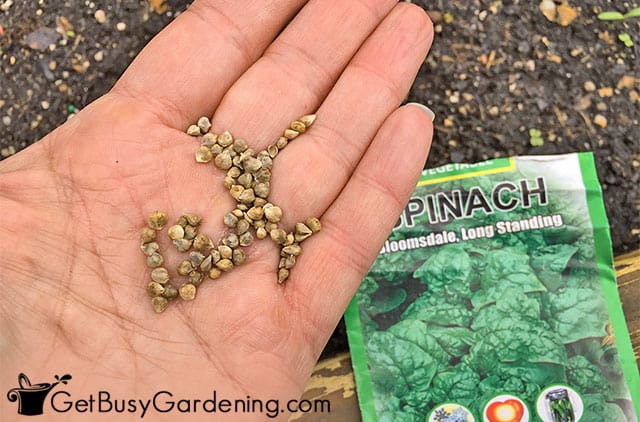
How Long From Seed To Harvest?
It takes about 30-50 days to grow spinach from the time you plant the seeds to when you can expect a sizable harvest. But you can usually start picking small amounts before then, which is great.
Some varieties are faster than others, so the exact time it takes yours to mature will depend on the type you have, as well as the climate and environmental conditions.
Related Post: How To Grow Spinach
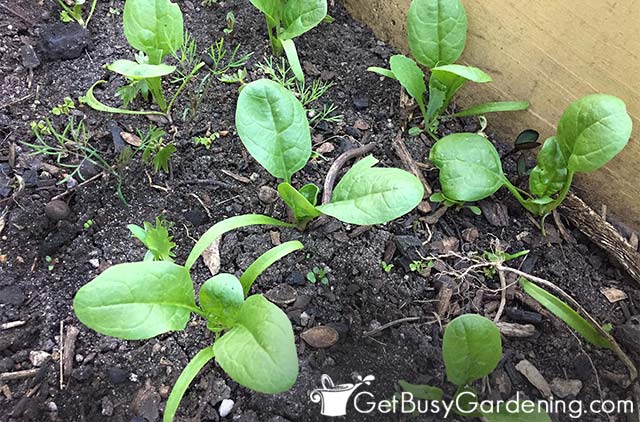
Tips For Planting Spinach Seeds
In this section, I’ll talk about exactly when and how to plant your spinach seeds so you can easily get it right every time.
Spinach Seed Starting Methods
There are 2 techniques you could use for starting your spinach seeds: 1. direct sowing, 2. starting them indoors.
- Direct sowing (best method) – The easiest way to grow spinach seeds is to plant them directly into your garden. It’s actually really nice, because that means you don’t have to worry about buying any equipment or caring for the seedlings indoors.
- Starting them indoors – While you could start them indoors, I don’t recommend it. The seedlings don’t like to be transplanted, and doing so can trigger them to bolt prematurely. If this is your only option, then use either plantable pots or pellets to help minimize the transplant shock.
Related Post: 3 Seed Starting Methods That Every Gardener Should Try
When To Plant Spinach Seeds
Spinach seeds grow best in cold weather. So you should direct sow them 4-6 weeks before your average last frost date, or as soon as the soil is workable in early spring.
If you plant them too late, they may not germinate if it’s too warm, or the heat could trigger the seedlings to bolt right away.
If you live in a warmer climate with mild winters, plant them once the weather cools down in the fall, and enjoy it through the winter.
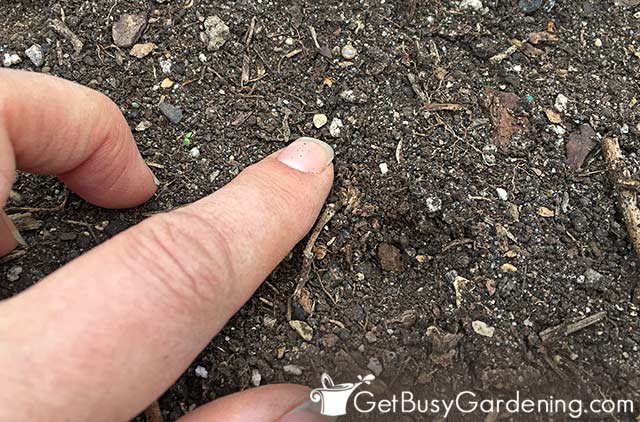
Spinach Seeds Germination Time
On average, it only takes about 5-10 days for spinach seeds to germinate and for the seedlings to start emerging.
If it’s too warm or overly wet, it can slow down or inhibit germination. So if yours aren’t growing, then use a soil thermometer to check that it’s below 70°F, and make sure it’s not dried out or soggy.
What Do Spinach Seedlings Look Like?
When they first pop out of the ground, baby spinach seedlings will have two long and narrow leaves. These are called the “seed leaves”. All of the ones that grow after that are called “true leaves”.
The true leaves look like the mature ones, only they are much smaller. It takes a couple of days for those to start forming after the seed leaves unfurl.
Related Post: Freezing Spinach With Or Without Blanching
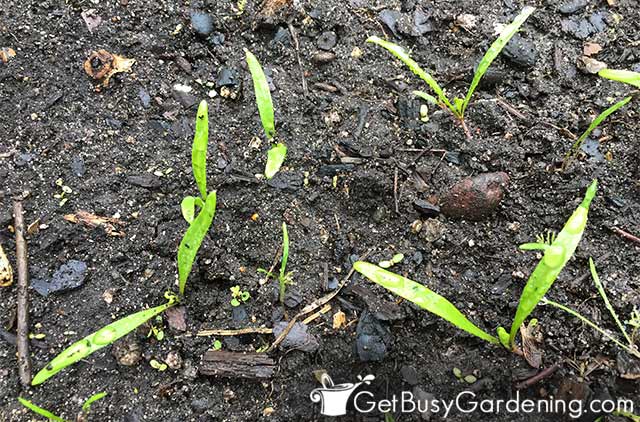
How To Care For Spinach Seedlings
Since it’s best to direct sow the seeds, you don’t need to worry about caring for your spinach seedlings indoors. Woohoo! But they’ll still need some TLC to grow strong and healthy, so below are a few tips to help you succeed.
Water
Spinach seedlings need even and consistent watering, so never let the soil dry out completely or become saturated.
A moisture gauge is a handy little tool to help you get it just right, and the reading should stay between 4 and 6.
Fertilizer
As soon as they begin growing their first true leaves, you can give them a half dose of liquid fertilizer. I recommend either using an organic compost tea, or get tea bags to brew your own. They love fish emulsion and liquid kelp too.
You could also top-dress them with slow-release granules to give them the extra nutrients they need.
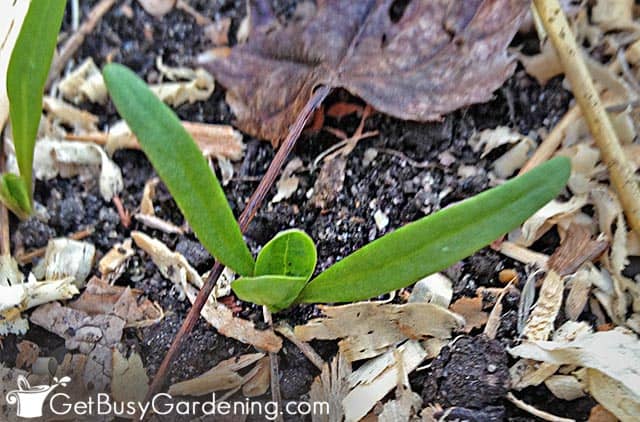
Thinning
If you planted more than one spinach seed per hole, or they’re growing too close together, then you’ll need to thin out the seedlings. Otherwise they will crowd each other out, which means you’ll end up with leggy and sparse plants.
Once they get to be about 2″ tall with a few sets of true leaves, pinch out the extras so the one’s that are left are spaced about 4-6″ apart.
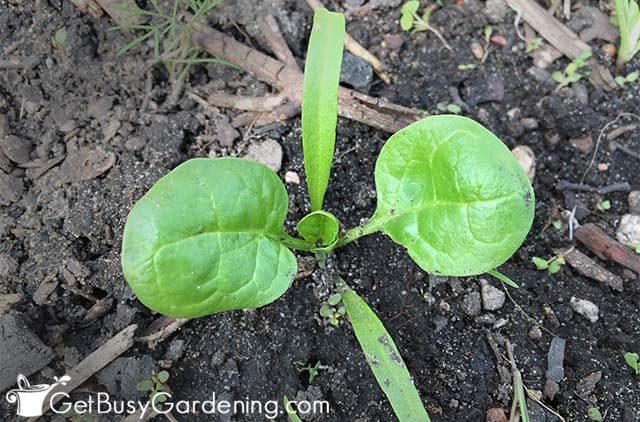
FAQs
No, spinach seeds do not need light to germinate.
If your spinach won’t germinate, then it’s either too warm, the soil is too wet or dried out, or your seeds are old. The soil should be evenly moist and between 50-70°F. If your seeds are more than 2 years old, then sow 2-3 per hole.
You do not need to soak your spinach seeds before planting them, but it can help to speed up germination.
Growing spinach from seed can be tricky if you don’t know how. Remember, timing is everything and the secret to success is planting them early, before the weather starts to warm up in the spring.
If you’re tired of struggling, and want to learn how to grow any plant you want from seed, then enroll in my online Seed Starting Course. It’s a wonderful, fun, self-paced course that will teach you everything you need to know to easily grow your own seedlings. Enroll and get started today!
Or, if you just need a refresher, then my Starting Seeds Indoors eBook is for you! It’s a quick-start guide that will get you planting seeds in no time.
Share your tips for growing spinach from seed in the comments section below.
Printable Step By Step Instructions
How To Plant Spinach Seeds Step By Step
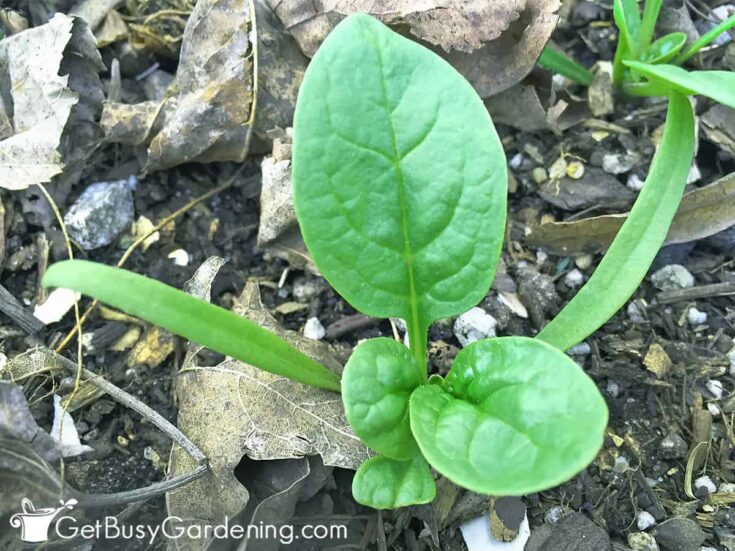
It's easy to plant spinach seeds, and they grow very fast. Follow these step-by-step instructions for the best results.
Materials
- Spinach seeds
- Water
- Compost (optional)
- Worm castings (optional)
- Granular fertilizer (optional)
Instructions
- Prepare the soil - Loosen up the soil, and remove any weeds, or large rocks and sticks. Amend poor soil with compost or worm castings, or mix an organic granular fertilizer into it.
- Figure out the spacing - You can either space the seeds 2" apart and thin them later, or space them 4-6" apart.
- Plant the seeds - You should sow your spinach seeds about a 1/2" deep. If you're using fresh ones, then you only need one per hole, otherwise if they are old, then plant 2-3. You can either lay them on top of the soil, and gently push them down, or make holes first and drop them in.
- Bury the seeds - Once you're done, cover them with soil, and gently press it down. Don't pack it tight, but just enough so that the soil will come in contact with the spinach seeds.
- Water - Use a low setting on your garden hose so you don't displace the seeds, then water the bed until the soil is evenly moist. Don't overdo it though, it should not be completely saturated or soggy.
Notes
- Spinach seeds need cool temperatures to germinate. So plant them as soon as the ground is workable in early spring, and use a soil thermometer to make sure it's between 50-70°F.
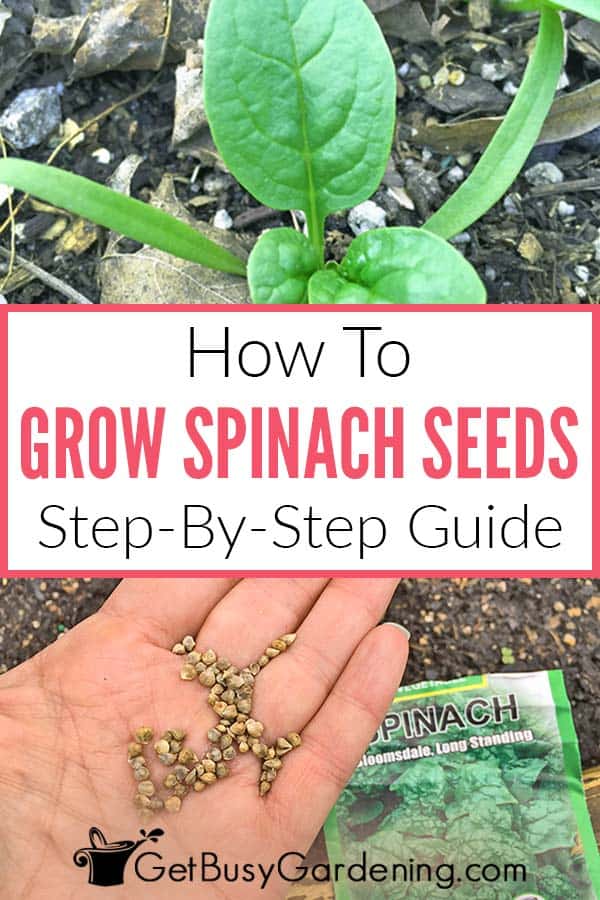
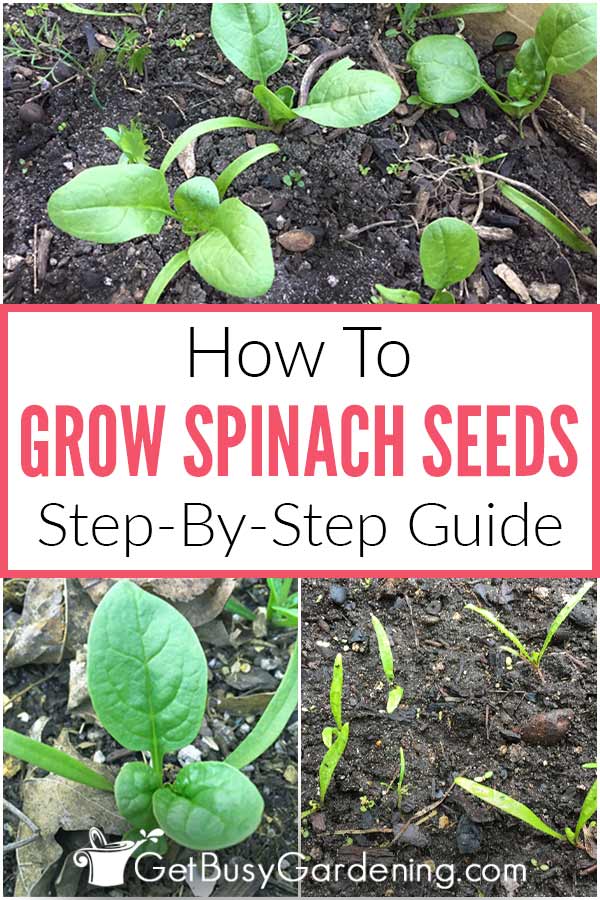

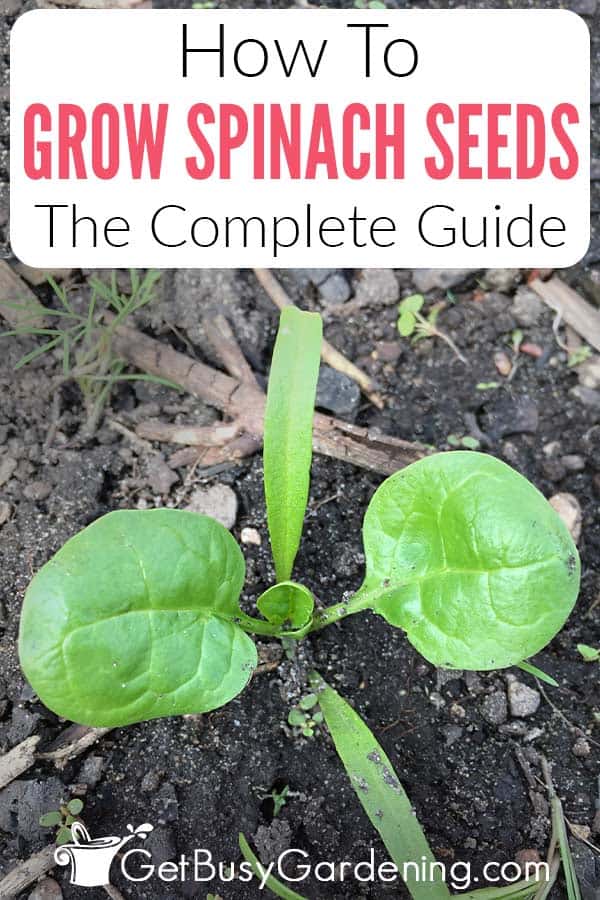
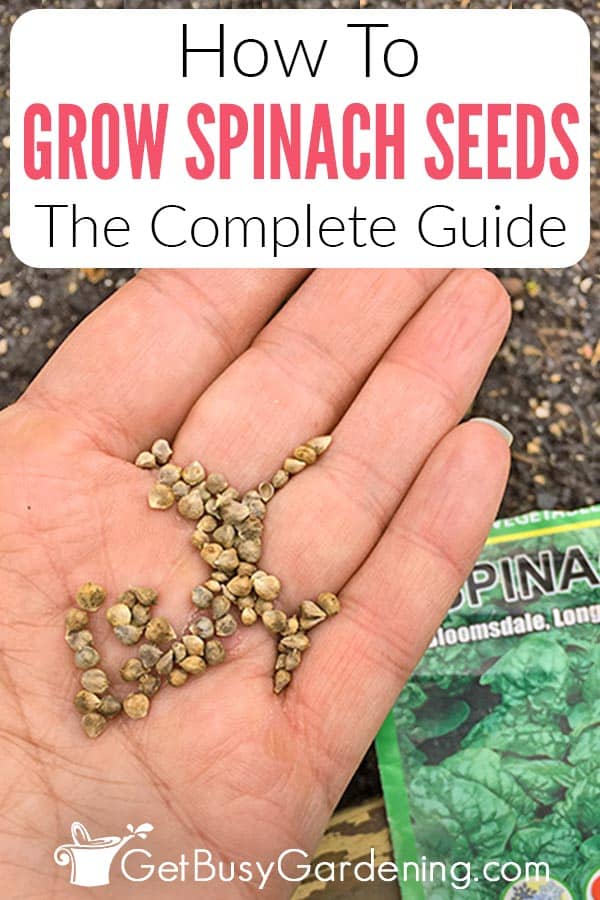
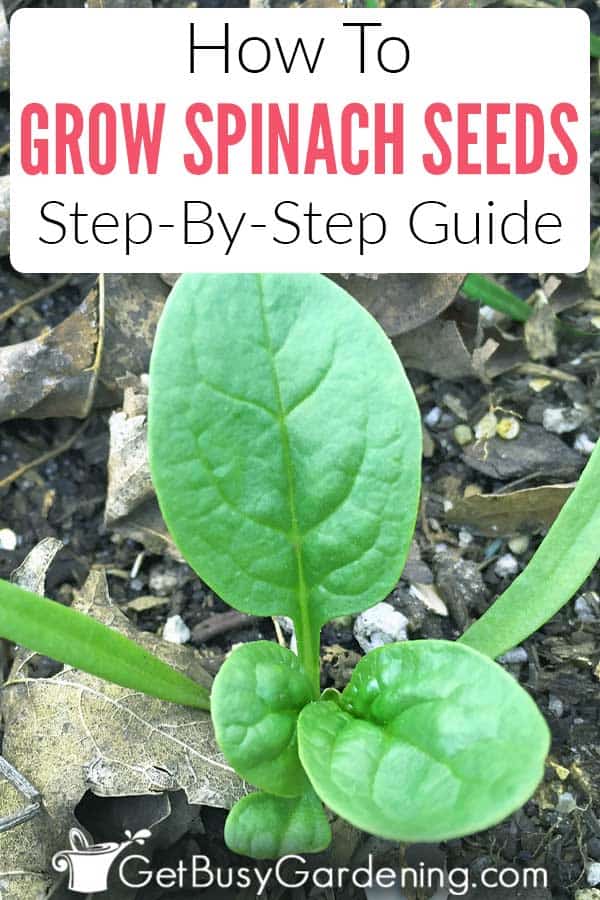
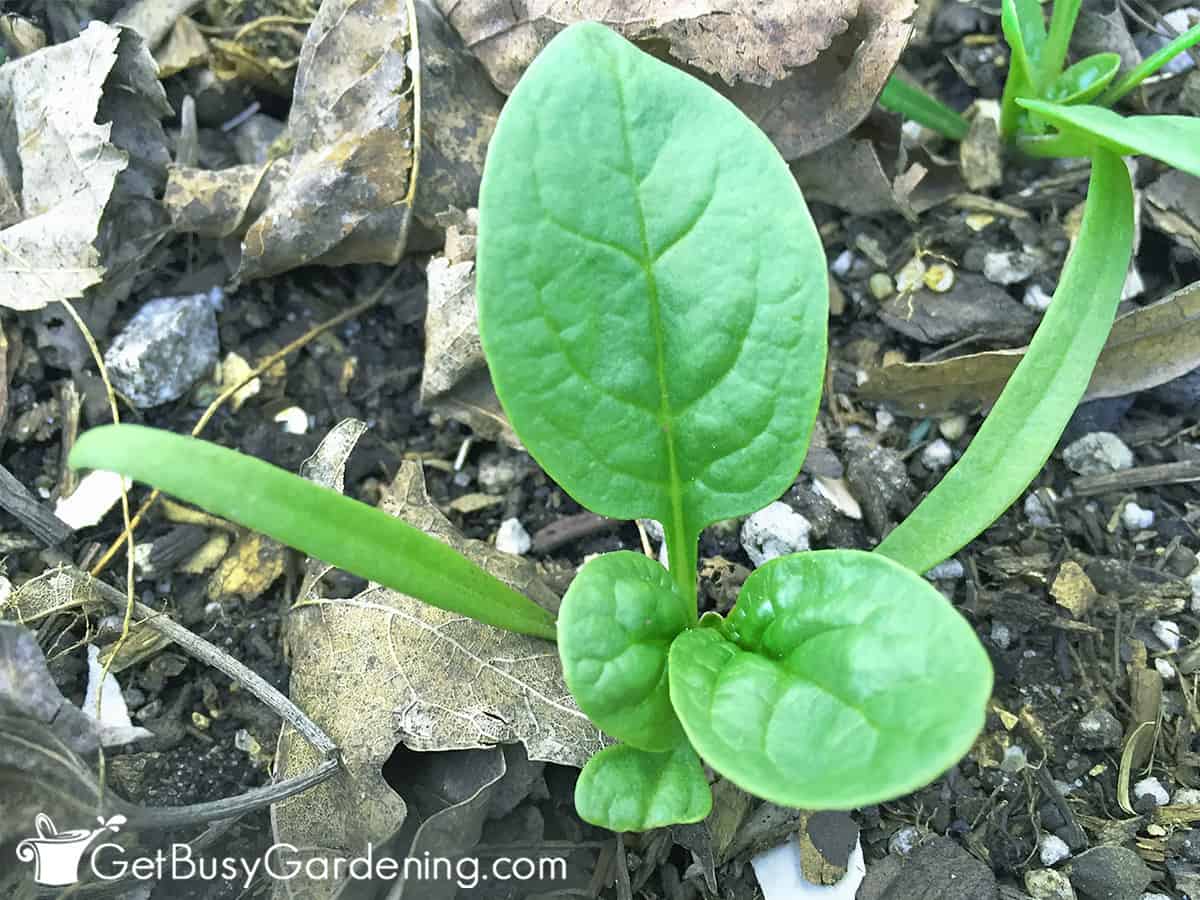



Charles murimi says
Booom!!! so it isnt a must i use a seedbed?? Trying it FOLKS!
Amy Andrychowicz says
Yes, it’s actually best if you don’t plant spinach seeds in a seed tray, direct sowing them is the way to go!
LAWRENCE W SCHIAVON says
Have been growing great spinach for years, Last 3 years spinach has been poor. Plants are small and leaves turning yellow. I put compost and lime in my garden yearly but maybe it is too much. Any good advice?
Amy Andrychowicz says
The main cause of spinach leaves turning yellow is usually improper watering (either too much or too little). They like to stay evenly moist at all times, but never soggy. They like alkaline soil that’s rich in nutrients, so it could be a problem there. It’s always a good idea to test your soil to make sure you’re maintaining the proper balance of nutrients, rather than just adding the same amendments every year. Here’s my full spinach growing guide for more information.
Marie says
I planted mixed green lettuce and spinach. They both started to germinate, but I was away from home for two weeks, so they did not get watered. Ugh. I have been watering them since then but have seen no sprouts. Do I need to dig up and replant new seeds or is there still hope?
Amy Andrychowicz says
If the seeds started to germinate before you left, and now there’s no sign of growth, then I think your tiny spinach seedlings have probably died. If any of the seeds didn’t start to germinate, then there’s still hope. But, if you saw green before, and now you don’t, then I think it’s best to start over with new seeds.
Marie says
Amy, your information is very helpful and much appreciated. One more question: I plan to start over with new seeds, so do I need to dig up the old seeds or can I use the same planter box and soil and just plant new seeds?
Amy Andrychowicz says
I would just plant the new seeds. My guess is that you probably won’t even find the old ones if you tried digging them up.
Sandra says
hi Amy,
I am growing spinach seed under lights in my basement this year here in St. Paul. It is my first time and everything was looking good until the leaves are starting to turn dark. Is this a natural progression from the bright green to the dark green? They seem a little red. The red isn’t in the veins which indicates phosphorous but I’m the meat out surface. Any helpful advice?
Amy Andrychowicz says
It might just be the variety of spinach that you planted. Some types have darker green leaves than others, and there are varieties that have red veins or redish colored leaves. Check the seed packet to see what the mature plant looks like, and give it a quick read to see if it says anything about the color.
Regina says
Hi! Thanks for the super-detailed explanation, it’s really helpful for beginners like me 🙂 anyway, I would like to ask. So, my seeds have sprouted a week ago and cotyledons have appeared. I germinate them in a jar container because I want to grow them hydroponically. However, the cotyledons now are curling and I’m afraid they will just die 🙁 maybe any suggestions what I should do?
Amy Andrychowicz says
The cotyledons are curling while they’re still inside the jar, or is it after you transplanted them into your hydroponic trays? I’m thinking you mean after, so if that’s the case, I have a feeling they are suffering from the chemicals, or perhaps from transplant shock. I would wait until they have at least their first set or two of true leaves before planting them. They tend to form pretty quickly after germination, so you shouldn’t have to wait too long.
Abhishek says
What time takes red spinach to harvest its seeds after sowing????
Amy Andrychowicz says
It depends on the temperature. Spinach will bolt much faster when it’s warm than it will when it’s cold. Sometimes spinach will bolt very quickly, but if the conditions are right, it will take several weeks.
Michael says
Hola! Greetings from Morelia, Mexico!
Sooooo, for those of us who love spinach–and want to grow it–but who happen to live in Mexico, is there hope?!?! (It’s almost always sunny and always warm here.)
“Average lows” are lowest in … Nov, Dec, Jan, Feb. Mar. (the 40s)
During those same months, the “average highs” are … mid- to upper-70s.
I was thinking of planting in a container, out on my patio. I guess I pay attention the “coolest” months, plant, and cross my fingers? (They do sell spinach seeds at the store, which is odd if spinach will just bolt with the heat while still young.)
Advice?
Amy Andrychowicz says
Well, you’re lucky to have such fantastic temperatures in the winter… but I guess that does make it harder to grow cool season crops like spinach. 🙂 Yes, you should definitely stick to growing it during the coolest months of the year. And plant it in the shade to protect it from the warm afternoon temperatures. There are slow-bolting spinach varieties that may work better for you, so look for those. Good luck!
M. says
Michael,
Check into “Malibar Spinach”. It climbs & can be grown through the summer. I’ve order some seed off of ebay myself. Hope this helps.
whmddc says
What an AWESOME writeup on planting, thinning, soil, and timing. I LOVE spinach and agree — super easy, but LOVED these tips. New to me. THANK YOU! 🙂
Amy Andrychowicz says
You’re welcome! Hope you’ll grow tons of spinach from seed this year! 🙂
Erin says
I am eager to plant my spinach seeds in my garden box but i’m worried it might be too early! It’s mid-March and last frost is supposed to be in about 2 weeks (Vancouver Canada) but due to a ridiculous snowfall and unusual freezing temps recently, most of the dirt in my box is frozen solid! Only the top few inches are loose. Should I wait?
Amy Andrychowicz says
As long as the soil is workable, you can start sowing your spinach seeds. They are pretty hardy, and the last few spring frosts (and even a late snowfall) won’t hurt them. Have fun!
Marie Penela says
Can I grow spinach in a pot. If so how deep does the pot need to be?
Amy Andrychowicz says
Yes you sure can. Spinach doesn’t need a very deep pot, so any standard sized container would work fine. I like to grow mine in decorative bowls or other shallow containers to save on soil a bit, since spinach roots are shallow.
Marcela says
Great tips! I always had difficulty growing spinach until I started doing this: I pre germinate the seeds by putting them in a humid paper towel that I then put in a zip loc bag or plastic container. I then leave them 12 hours on my kitchen counter and 12 hours in the fridge for a few days until they germinate and I sow them afterwards. I have a great germination rate using that method. For a spring harvest I start them inside in February and then plant the seedlings in early March in a cold frame. I’m in zone 4 (in southern Quebec) so our spring weather is often cold, but spinach does great, it’s always the first vegetable that I’m able to harvest.
Amy Andrychowicz says
Awesome, thanks for sharing your method for germinating spinach seeds, and your growing tips!
Jeff Anderson says
I’m going to try your method. I’ve never had much success growing spinach. Is it 12 hours in the fridge, or a few days in the fridge?. I have a 4 season room where I grow romaine lettuce and cabbage family plants under lights during the winter. I’ll use the 4 season room instead of the fridge since I’m currently keeping it at 42F (6C) I’m also storing this years crop of potatoes and delicata squash in the room. We’re zone 5-6 near Milwaukee.
Jeff